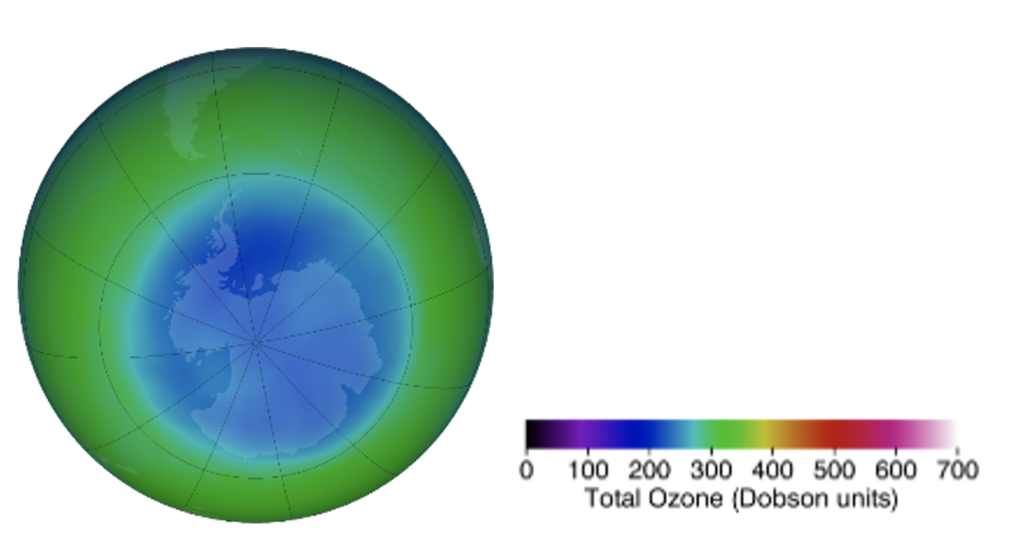
September 16: International Day for the Preservation of the Ozone Layer
The Montreal Protocol
The depletion of the ozone layer by chlorofluorocarbons (CFCs) and other substances was one of the most pressing environmental problems of the 1980s. The International Day for the Protection of the Ozone Layer commemorates the signing of the Montreal Protocol on Sept. 16, 1987. The agreement entered into force in January 1989. Signatory states pledged to reduce and eventually eliminate emissions of chlorine- and bromine-containing chemicals that destroy ozone in the stratosphere. The Montreal Protocol has been ratified by all states. At the annual Conferences of the Parties, progress of the agreed measures and the further development of the Montreal Protocol is discussed.
The worldwide implementation of the Montreal Protocol is considered a success. Ozone measurements and satellite data show that the ozone decline has been stopped and the ozone density has been trending upward again since the beginning of the millennium, although strong annual fluctuations are observed. These are due to too much CFC still remaining in the atmosphere, which can lead to low ozone levels in some years. An ozone density like in the 1960s is not expected until the second half of this century at the earliest, because the regeneration of the ozone layer is slow due to the long lifetime of CFCs.

35 years of the Montreal Protocol: despite successful implementation of the measures, the ozone layer is not expected to recover before mid-century, as elevated levels of CFCs are still present in the atmosphere today.
Illustration of ozone concentration over Antarctica, August 2022 © NASA Ozone Watch.
The challenge of climate change: the Kigali Amendment
The Montreal Protocol initiated the global phase-out of CFC production and use. Today, the phase-out of CFCs and their successors, hydrochlorofluorocarbons (HCFCs), is largely completed. However, the partially fluorinated hydrocarbons (HFCs) introduced as replacements contribute significantly to climate change due to their high global warming potential. Among other things, they are still used today as refrigerants in air conditioning and refrigeration technology.
In response to the sharp rise in consumption of HFCs as substitutes for CFC, these were included as a new group of substances in the Montreal Protocol at the 28th Conference of the Parties in Kigali in 2016. By 2047, their quantity is to be reduced to 15-20% of baseline levels. It is estimated that full implementation of the Kigali Amendment will avoid 0.2°C-0.4°C of additional global warming by the end of the century.
The challenge is great: a recent study by the Climate and Clean Air Coalition on the impacts of HFC use in Article 5 countries illustrates the importance of the Kigali Amendment: without action, emissions are projected to double from 1,001 Mt CO2eq in 2020 to 2,367 Mt CO2eq by 2032 and up to 4,853 Mt CO2eq by 2050. In contrast, strict implementation of the Kigali schedules would reduce consumption to 319 Mt CO2eq by 2050. The study assumes that 56.4% of HFC consumption occurs in the refrigeration sector. However, the study is critical of the achievement of the targets for many countries if strict measures are not taken immediately to reduce HFC consumption.
The future lies with natural refrigerants
Environmentally and climate-friendly alternatives to the use of HFCs already exist. Proven technical solutions are available in all important areas of application. Natural refrigerants such as ammonia, water, CO2 and hydrocarbons have a low global warming potential and can be used as HFC substitutes. Units and systems using these refrigerants have proven themselves in practice and are characterized by comparable or better energy efficiency compared to HFC units and systems. The market continues to evolve. So despite significant challenges, a switch is possible! The Montreal Protocol with its established control and financing systems is an effective instrument for implementing climate measures – as the success in protecting the ozone layer has shown.
To promote the switch to natural refrigerants in the small food trade in Europe, the EU-funded RefNat4LIFE project brings together end-users of appliances and representatives of the refrigeration and air conditioning sector. A wide range of free information and training offers support plant operators and specialist companies in their decision to use natural refrigerants.
Find more information about the RefNat4LIFE project and our free online courses, practical examples and training course databases at www.refnat4life.eu.
